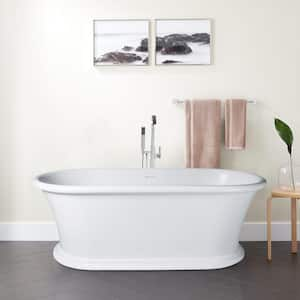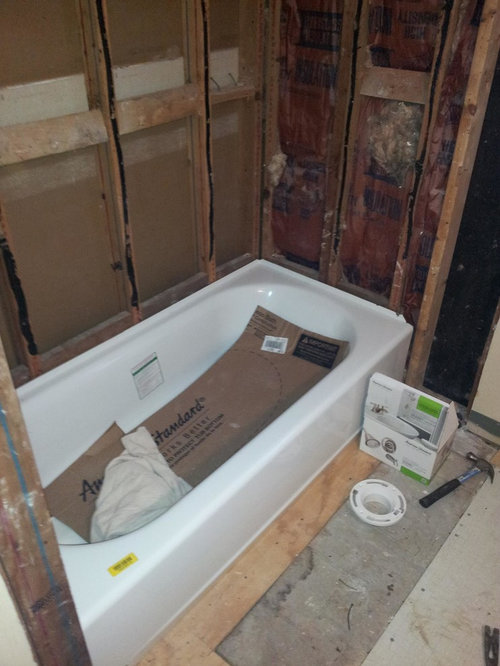How to Replace a Bathtub Yourself: Removing and also Replacing.
How to Replace a Bathtub Yourself: Removing and also Replacing.
Blog Article
What're your opinions regarding How to Install a Bathtub Yourself?

Installing a tub isn't specifically rocket science, however it does call for solid plumbing, carpentry, and also sometimes, tiling skills. Replacing an old bath tub with a new one is also a moderately challenging job. If the old bathtub is readily available, the task can relocate quickly; if you have to open up a wall surface to eliminate the old tub as well as position the new bathtub, the task is much harder. In either case, the project is within a residence handyman's abilities, although you will certainly require an assistant to leave the old bathtub and set in the brand-new one. Make sure you have qualified yourself for the work and also fit attempting it. Rather than employing a specialist to take over a halfway-completed project, it is much better to think about utilizing one prior to you start. Opportunities are you might require a professional plumber to make tube connections.
This short article will assist you set up a new tub in your shower room if you have currently gotten a brand-new bathtub as well as do not require to alter the plan of your previous water system pipes.
Your devices and also material checklist need to make up the following:
Removing Old Taps
If you require to change old faucets with brand-new ones as a part of your installment, after that the first thing you must do is detach the water system. After doing so, turn on the taps to drain any kind of water continuing to be in the system. The procedure of getting rid of the existing faucets can be fairly problematic as a result of the limited accessibility that is commonly the situation.
Utilize a basin wrench (crowsfoot spanner) or a tap device to reverse the nut that links the supply pipelines to the faucets. Have a fabric ready for the remaining water that will certainly originate from the pipes. Once the supply pipes have actually been eliminated, utilize the same device to loosen up the nut that holds the taps onto the bath/basin. You will certainly need to stop the solitary faucets from turning during this procedure. When the taps have actually been eliminated, the holes in the bath/basin will have to be cleansed of any kind of old securing compound.
Before going on to fit the new taps, contrast the pipe connections on the old faucets to the new taps. If the old faucets are longer than the new taps, after that a shank adapter is needed for the brand-new taps to fit.
Suitable New Taps
If the tails of the new faucets are plastic, then you will certainly require a plastic connector to stop damage to the thread. One end of the adapter fits on the plastic tail of the faucet as well as the other end supplies a connection to the current supply pipes.
If you need to fit a monobloc, after that you will call for decreasing couplers, which connects the 10mm pipeline of the monobloc to the basic 15mm supply pipeline.
Next, position the faucet in the installing hole in the bath/basin making sure that the washers remain in place in between the tap and also the sink. Protect the tap in position with the manufacturer supplied backnut. Once the faucet is securely in position, the supply pipes can be attached to the tails of the taps. The faucets can either be connected by utilizing corrugated copper piping or with normal tap adapters. The former kind ought to be connected to the faucet ends initially, tightening up only by hand. The supply pipelines can later on be connected to the various other end. Tighten up both ends with a spanner after both ends have been attached.
Installing the Tub
Using the two wood boards under its feet, place the tub in the called for position. The wood boards are helpful in uniformly spreading out the weight of the bathtub over the area of the boards as opposed to focusing all the weight onto 4 tiny factors.
The next goal is to make certain that the bathtub is leveled all round. This can be accomplished by examining the level and also adjusting the feet on the tub till the spirit level checks out degree.
To mount taps, fit the bottom of the furthest flexible tap port to the suitable supply pipe by making a compression join; then do the exact same for the other tap.
Turn on the supply of water as well as inspect all joints and brand-new pipework for leakages and also tighten them if necessary. Fill up the tub and likewise inspect the overflow electrical outlet and also the normal outlet for leaks.
Lastly, deal with the bathroom paneling as described in the producer's instruction manual. Tiling as well as securing around the bath tub needs to wait until the bathtub has been utilized a minimum of when as this will certainly resolve it into its final setting.
Getting ready for the Installment
To start with, the sustaining framework provided with the bathroom needs to be fitted (if called for) according to the supplier's guidelines. Next off, fit the faucets or mixer to the bathtub. When suitable the faucet block, it is very important to ensure that if the tap comes with a plastic washer, it is fitted in between the bathroom as well as the taps. On a plastic bath, it is also reasonable to fit a sustaining plate under the faucets system to prevent strain on the bath tub.
Fit the versatile tap adapters to the bottom of the two faucets utilizing 2 nuts and olives (occasionally provided with the tub). Fit the plug-hole electrical outlet by smearing mastic filler round the sink electrical outlet hole, and afterwards pass the electrical outlet through the hole in the bath. Make use of the nut provided by the producer to fit the plug-hole. Examine the plug-hole electrical outlet for an inlet on the side for the overflow pipeline.
Next, fit the end of the adaptable overflow pipeline to the overflow outlet. Afterwards, screw the pipe to the overflow face which ought to be fitted inside the bath. Make sure you use every one of the provided washing machines.
Link the trap to the bottom of the waste outlet on the bath tub by winding the string of the waste outlet with silicone mastic or PTFE tape, and screw on the trap to the electrical outlet. Attach the bottom of the overflow tube in a similar manner.The bathroom must now be ready to be suited its last setting.
Tiling Around the Bathtub
In the location where the bath meets the floor tile, it is needed to secure the accompanies a silicone rubber caulking. This is essential as the fitting can relocate enough to crack a rigid seal, creating the water to pass through the wall in between the bathroom and the tiling, leading to issues with moisture and also feasible leaks to the ceiling listed below.
You can select from a variety of coloured sealers to blend in your components as well as fittings. They are offered in tubes and cartridges, and also are capable of securing spaces up to a size of 3mm (1/8 inch). If you have a bigger gap to load, you can fill it with spins of soaked paper or soft rope. Keep in mind to always fill up the bathtub with water prior to sealing, to permit the movement experienced when the bathtub is in usage. The sealant can fracture fairly very early if you do not consider this activity before securing.
Alternatively, ceramic coving or quadrant ceramic tiles can be used to border the bath or shower tray. Plastic strips of coving, which are easy to use and also cut to dimension, are additionally easily offered on the market. It is a good idea to fit the tiles utilizing waterproof or waterproof sticky and also grout.
Bathtub Installation
How Important Is A Bathtub To Your Home?
High-quality baths, showers, and other bathroom updates are necessary when considering a smart investment in your home. It’s a room that you go to every day and one that is constantly being used by guests.The bathroom is one of the top trafficked rooms in a home and also one of the most valuable in terms of home resale.
Install Piping Before Tub
You will be using your existing drain and waste vent system, but pipes required include the hot and cold water supply lines and a pipe leading to a shower head. A mixing valve and shower head are also needed. Air chambers may be required.
Position the Tub
Lower the tub into place so that the continuous flange fits against the wall studs and rests on 1’x4' or 2’x4' supports. Anchor the tub to the enclosure with nails or screws inserted through the flanges into the studs.
NOTE: Remember, bathtubs and shower stalls may require support framing. A bathtub filled with water is extremely heavy, so check building codes and framing support before installing the tub.
Assemble Drain Connections
Assemble the bathtub drain connections by connecting the tub overflow with the tub drain above the trap, not beyond it. The trap will have a compression fitting that screws over the arm of the overflow assembly.
Place a Pipe For the Shower Head
First, locate a brass female threaded winged fitting and attach it to a framing support via a screw or a nail. Then run a pipe up the wall for the shower head. Sweat or solder the other side of the brass fitting to the top of the pipe.
Attaching Hot and Cold Water Lines
Attach your water lines for both hot and cold by sweating these directly into the hot and cold ports of the mixing valve. The mixing valve will be how water enters the tub’s system, not by the pipes themselves.
Install the Spout
Extend a piece of 1/2 inch pipe, or whichever length is specified in the manufacturer’s instructions, for the tub spout. Sweat on a male threaded fitting at the end of the pipe or use a brass nipple of the proper length and a 1/2 inch cap.
NOTE: At this point you should have your rough-in plumbing work inspected before proceeding further.
Check For Leaks
Restore the water pressure and check the drain connection and the supply pipes for any sign of leaking.
estore the Bathroom Wall
Replace the wall with moisture-resistant drywall as a base for your wall covering. Seal the joints between the wall and your new tub with silicone caulk as protection against water seepage.
https://www.berkeys.com/2016/12/02/bathtub-installation-dallas/

I am very curious about A Step-by-Step Guide to Installing a Bathtub and I am praying you enjoyed reading the entry. Do you know about anybody else who is interested by A Step-by-Step Guide to Installing a Bathtub? Take a moment to share it. We love reading our article about Installing A Bathtub.
Get An Estimate Report this page